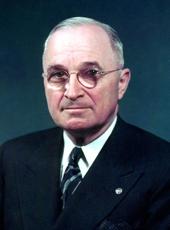THE LEGISLATIVE Reorganization Act of 1946, which I signed today, is one of the most significant advances in the organization of the Congress of the United States since the establishment of that body.
Both as United States Senator and as President, I have had occasion to observe some of the outmoded organizational and procedural traditions that have burdened the Legislative Branch. The problem of reorganizing and modernizing the Congress has been a peculiarly difficult one, and session after session the members of the Congress found themselves unable to take decisive steps in tackling the problem.
The Seventy-ninth Congress, however, approached the task with vigor and in a sound and orderly manner. I have nothing but admiration for the way in which the investigation of Congressional organization was conducted and particularly for the leaders who formed the special investigating committee and who wrote and sponsored the bill.
I realize that in the process of Congressional consideration, compromises and adjustments had to be made and some desirable provisions were deleted. However, the passage of this Act shows that progress can be made, and I anticipate that the Congress will continue to pay attention to those parts of the legislative reorganization problem not yet solved.
The present Act should permit easier and closer relations between the executive agencies of the Government and the Congress. The expanded staff of the Congressional committees and of the agencies in the Legislative Branch can become a valuable link between the policy-making deliberations of the Congress and the practical administrative experience of the Executive Branch.
The Legislative budget and the provisions on the handling of appropriations will undoubtedly result in clearer and more realistic relationships between the income and expenditure sides of the budget. Further, the changes in the dates for the transmitting of the President's economic report and the report of the Joint Committee on the Economic Report, required under the Employment Act of 1946, will result in proper integration between the legislative budget and the national program for maximum employment. The Joint Committee will not present its findings and recommendations to the Congress before February first. The four revenue and appropriation committees in carrying out their new responsibilities under the Reorganization Act, therefore, will have the benefit of the joint Committee's report for their overall appraisal and recommendations on Federal receipts, expenditures, debt and surplus. This timing is essential today when Federal fiscal policy is so closely related to the Nation's economic conditions.
One other provision of the bill deserves special praise--that which raises the salary of members of Congress from $10,000 to $12,500 plus an expense allowance of $2,500. This is a long overdue step in providing adequate compensation for our Federal legislators.
Note: The Legislative Reorganization Act of 1946 is Public Law 601, 79th Congress (60 Stat. 812).
Harry S Truman, Statement by the President Upon Signing the Legislative Reorganization Act. Online by Gerhard Peters and John T. Woolley, The American Presidency Project https://www.presidency.ucsb.edu/node/231977

